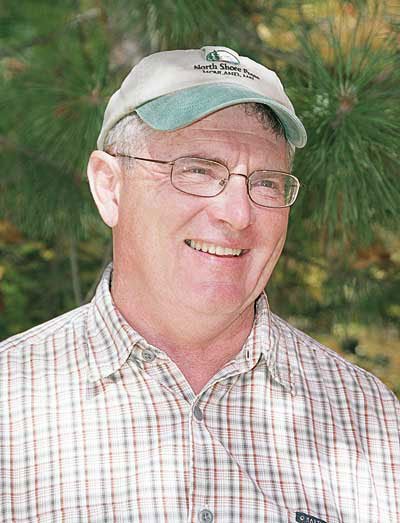The hunter in the tree stand was over 100 yards away, across a plantation of waist high white spruce. Stepping out slow and quiet from the big timber, I saw him first. To be polite, I changed my course to skirt wide around him and not mess up his hunt.
When a hunter is unaware of your presence, it is wise to stay very aware of him. You don’t want to startle someone who is carrying a gun. I saw the distant hunter slowly turn and spot me. He watched me for a long moment, and then up came his gun.
There are a few places in this world where I never want to be. Looking down the business end of a deer rifle is high on the list. I considered hitting the dirt, but I was standing in the open dressed head to toe in blaze orange, so he obviously knew I was a hunter. He was using his rifle scope to get a better look at me.
Whether he was just curious or making a passive-aggressive threat to keep me out of “his” hunting area was not my concern. Walking over to confront an armed man in a tree would be a foolhardy waste of time. I just kept going. He finally took the scope off me as I moved away.
This incident happened about 15 years ago on public land. My hunting partners heard the story, but we didn’t report it to a conservation officer. What would be the point? No law was broken. And a talking-to from a CO almost certainly wouldn’t change the attitude or behavior of someone like that.
Now, let’s fast-forward to a couple of years ago. I was walking out of the woods on a forest trail at dusk, moving quickly and silently on moist ground. The hunter huddled beneath a balsam beside the trail never heard me approach. I was close enough to kick him before we were aware of one another, because he was completely dressed in camouflage–on the opening weekend of the firearm deer season. He was watching over a freshly seeded area beside a well-travelled county road. If he shot at a deer, his backdrop was the road 50 yards away and an occupied home at less than 200 yards.
“You’re not wearing orange,” was my less-than-chipper greeting.
“I took it off and put it in my pack,” he replied.
“Wearing orange is the law,” I said and continued on my way. I hope he got the message.
Maybe the hunter took off his orange because he didn’t want to be seen from the road. More likely, he had a foolish notion that with camo he was better concealed from the deer. I’ve got a feeling he’s not the only Minnesota deer hunter who dresses that way, nor the only one foolish enough to shoot toward a road.
It seems a little crazy to trade your own safety by taking off your hunter orange in a dubious attempt to up your odds at killing a deer. Then again, the basics of hunter safety seem to have taken backseat to other priorities these days. Consider, for instance, the recent surge in popularity of ground blinds.
I’ve stumbled across a handful of these contraptions while hunting on public land. Constructed of camouflage fabric, they are always a close-range surprise. You don’t know if they are occupied, because you can’t see into them. Since whoever may be inside is likely basking in the artificial warmth of a propane heater, it’s very possible they’ve removed their hunter orange outerwear anyway.
Now I’ll be damned if I’d sit inside a camouflaged tent while a half million hunters are roaming the woods during the Minnesota firearm season. Chalk that up to a powerful instinct for self-preservation. But what really floors me is that it is perfectly legal do so in this and other states. You would think the powers that be would require a certain amount of hunter orange material to be visible from every angle on a ground blind for hunter safety. Isn’t that just common sense? Seriously, how dumb are the people who are running the show?
Maybe they’re not dumb (I’ll reserve judgement here), but are instead marching to drummers of different priorities. The hunting industry and its standing army of celebrity “experts” preach a seductive gospel of hunting success based upon the products you buy rather than the skills you acquire with field experience. While previous generations of hunters killed millions of deer with no more than a red wool shirt and a lever-action .30.30, today’s nimrods spend more time (and money) at outdoor gear box stores than they do in the deer woods. It seems just about every new hunting product, even if it pushes the envelope regarding the premise or fair chase or, as with ground blinds, hunter safety, inevitably makes its way to mainstream hunting.
Then there is the holy gospel of hunter recruitment. Driven largely by hunting’s nonprofit community, this gospel at times reaches the fever pitch of a 19th Century travelling salvation show. Fearful of changing population demographics and an increasingly urbanized culture, the recruitment prophets preach that we must save the hunting souls of children, the younger the better. We have to get guns in their hands and, through the relaxation of long-standing rules for hunter safety and hunting seasons, attempt to give them the sort of instant gratification they’ve come to expect when fiddling on a Gameboy.
For rank-and-file hunters, this gospel is promoted with the kind of imagery that is best compared to a Facebook kitten video: staged pictures of pre-teen children dressed in camouflage huddled shoulder-to-shoulder with a similarly dressed loving parent, sharing precious moments in the Great Outdoors. State legislatures, swept up in the “aw, ain’t that cute,” spirit of the movement, have swept aside tried-and-true firearm safety program requirements for young hunters for “mentoring” programs that allow pre-teens to hunt big game, provided they are accompanied by an adult “mentor.” In an effort to recruit more women and, to a lesser extent, neophyte men to hunting, Minnesota has an adult “mentoring” program that allows such persons to hunt for two years without completing firearm safety training.
Now, just for a moment, let’s think about the fellow I mentioned at the beginning of this tale–the one who leveled the crosshairs on me. He can be a mentor, too.
Little, if any, evidence exists to demonstrate that kiddie hunts or mentoring programs have made a measurable contribution to the hunting population. If anything, the most noticeable driver of hunting recruitment seems to the factory-farmed meat we find in grocery stores. Across the country, droves of adult millennials are taking up hunting as a way to acquire chemical-free meat. Despite the fears of the recruitment prophets, a changing society is actually delivering new hunters to the fold.
Best of all, these new hunters want to learn how to do it the right way. The basics of firearm safety and hunter ethics are not an obstacle for “adult onset” hunters, but a welcome step in their path to adding hunting to their lives. The Minnesota DNR, through the capable work of hunter recruitment expert Jay Johnson, has wisely stepped forward to meet their needs.
The agency needs to make a similar effort to restore its emphasis on hunter safety. For instance, I paged through the 2015 handbooks for hunting and trapping and waterfowl regulations. The handbooks are the primary tool the DNR has to communicate with hunters, because nearly every license-buyer receives one. Within the hunting and trapping regulations there is a full-page graphic soliciting volunteer hunter education/firearm safety instructors and a full-page graphic saying children under age 10 are required to wear life jackets while boating. There are no safety messages. The waterfowl regulations contain no text or graphics for hunter or cold water safety either.
In contrast, the hunting and trapping regs contain two full-page graphics warning hunters about invasive species. The waterfowl regs have three graphics totaling two pages with the same message. I think this says something about the agency’s present priorities.
Minnesota has an excellent, decades-old hunter education/firearms safety program. In terms of preventing hunting accidents, we’ve come a long way forward from the days of red wool shirts and lever-action .30.30s. This doesn’t mean we should slack off on safety messages today or, realistically, ever. Instead we should strive to prevent shooting accidents, tree stand injuries, drownings and any hunting-related mishaps and calamities. The old saying that, an ounce of prevention is worth a pound of cure, remains true today.



